Stone Age Peoples - Neolithic - Sold antiquities
Archive of sold antiquities
All artefacts sold in our gallery are fully documented in our online archive and database. Being a specialist ancient art dealer, preserving also the more recent history of each and every piece sold in our shop is at our heart. That is particularly useful for artefacts that changed owners in the meantime. Information that may have been lost in the process can be easily restored from our archives. Please do not hesitate to contact us if you need further information about ancient items that have been sold in our gallery. We can help you with reconstructing the history of ownership for those items. All information about our customers will be kept confidential, of course.-
 Neolithischer Axtkopf mit Museumsschäftung
Neolithischer Axtkopf mit MuseumsschäftungDas Steinwerkzeug stammt aus der Jungsteinzeit Nord- oder Mitteleuropas. Besonders hervorzuheben ist die moderne Schäftung in Museumsqualität, die einen großartigen Eindruck von der einstigen Verwendung des Werkzeuges gibt.
Price: on request Flint knife from Northern Germany
Flint knife from Northern GermanyFlat two-edged stone blade from the Dagger Period of Northern Europe.
Price: on request Stone Age chisel from Northern Germany
Stone Age chisel from Northern GermanyAsymmetrically shaped chisel with two polished sides. Made of light flint. Approx. 3400 to 2400 BC.
Price: on request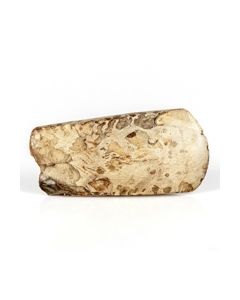 Neolithic thin butted axe head
Neolithic thin butted axe headAxe from the Early Neolithic is made of beautiful reddish brown flint with inclusions. Found in Northern Germany.
Price: on request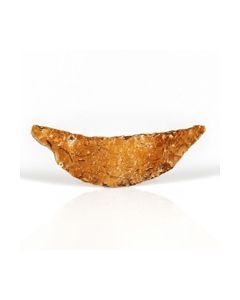 Small Neolithic sickle from Northern Germany
Small Neolithic sickle from Northern GermanyThe crescent-shaped blade is made of reddish brown flint. This tool represents an intermediate state within the radical transition from Neolithic to Bronze Age.
Price: on request Neolithic sickle from Northern Germany
Neolithic sickle from Northern GermanySmall crescent-shaped blade made of beautiful polychrome flint. This tool represents an intermediate state within the radical transition from Neolithic to Bronze Age.
Price: on request Small axe head from the New Stone Age
Small axe head from the New Stone AgeCompact stone axe from the 3rd Millenium BC. Found on the Danish island of Moen.
Price: on request Hammer axe of the Single Grave culture
Hammer axe of the Single Grave cultureGorgeous axe head made of polished dark rock. Made by the Single Grave culture and found in northern Germany.
Price: on request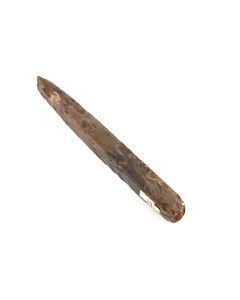 Neolithic chisel from Northern Germany
Neolithic chisel from Northern GermanyElegantly shaped chisel with two polished sides. Made of dark flint. Approx. 3400 to 2400 BC.
Price: on request Neolithic axe head from Luetzow in Northern Germany
Neolithic axe head from Luetzow in Northern GermanyPolished axe made of beautiful brown flint. It was found more than 100 years ago near the town of Luetzow.
Price: on request Dagger blade made of beautiful flint
Dagger blade made of beautiful flintThe finely worked long blade was found in Luetzow in Northern Germany. The artefact was made towards the end of the Neolithic.
Price: on request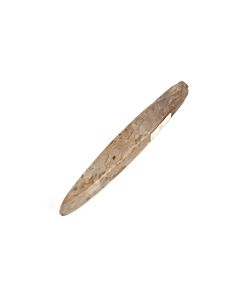 Neolithic chisel from Northern Germany
Neolithic chisel from Northern GermanyElegantly shaped chisel with two polished sides. Made of grey flint. Approx. 3400 to 2400 BC.
Price: on request Neolithic sickle from Northern Germany
Neolithic sickle from Northern GermanyCrescent-shaped blade made of beautiful grey flint. This tool represents an intermediate state within the radical transition from Neolithic to Bronze Age.
Price: on request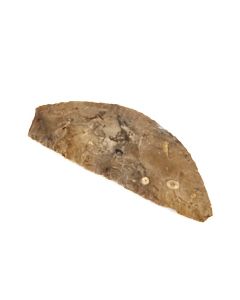 Neolithic sickle from Northern Germany
Neolithic sickle from Northern GermanySmall crescent-shaped blade made of beautiful grey flint. This tool represents an intermediate state within the radical transition from Neolithic to Bronze Age.
Price: on request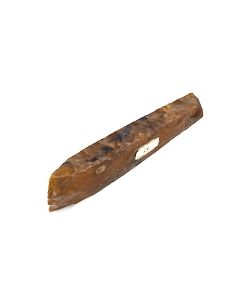 Neolithic axe head from Luetzow in Northern Germany
Neolithic axe head from Luetzow in Northern GermanyNice polished axe from brown flint. It was found more than 100 years ago near the town of Luetzow.
Price: on request Large storage vessel of the Linear Pottery culture
Large storage vessel of the Linear Pottery cultureThe imposing vessel was made by the earliest peasants of Central Europe, the Neolithic Linear Band Ware settlers. A find from Southern Germany in great condition.
Price: on request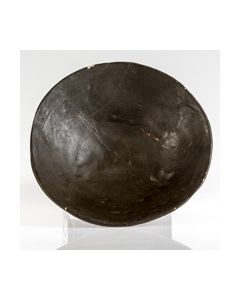 Bowl of the Linear Pottery culture
Bowl of the Linear Pottery cultureLarge flat bowl or deep plate from the earliest peasants of Central Europe, the Neolithic Linear Band Ware settlers. A well preserved piece found in Riekofen in Southern Germany.
Price: on request Vessel of the Linear Pottery culture
Vessel of the Linear Pottery cultureThe beautifully decorated tableware or cookware was made by the earliest peasants of Central Europe, the Late Stone Age Linear Band Ware settlers. A find from Southern Germany in great condition.
Price: on request Vessel of the Linear Pottery culture
Vessel of the Linear Pottery cultureThe beautifully decorated tableware or cookware was made by the earliest peasants of Central Europe, the Neolithic Linear Band Ware settlers. A find from Southern Germany in great condition.
Price: on request Vessel of the Linear Pottery culture in Mintraching
Vessel of the Linear Pottery culture in MintrachingThe beautifully decorated tableware or cookware was made by the earliest peasants of Central Europe, the Neolithic Linear Band Ware settlers. A find from Mintraching in Southern Germany.
Price: on request Vessel of the Linear Pottery culture
Vessel of the Linear Pottery cultureThe beautifully decorated tableware or cookware was made by the earliest peasants of Central Europe, the Neolithic Linear Band Ware settlers. A find from Southern Germany in great condition.
Price: on request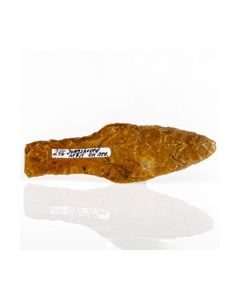 Scandinavian flint dagger
Scandinavian flint daggerNicely worked flint dagger from the transitional period between Late Neolithic and Early Bronze Age. Jungshoved on the Danish Island of Moen was the find spot.
Price: on request Neolithic dagger
Neolithic daggerNicely worked flint dagger of type III. Sprove on the Danish Island of Moen was the find spot. 1700 to 1500 BC.
Price: on request Axe head from neolithic Northern Europe
Axe head from neolithic Northern EuropeThe object is a trapezoid thick-butted thin bladed axe head dating to the Passage Grave Period to Dagger Period. 3200 to 1950 BC.
Price: on request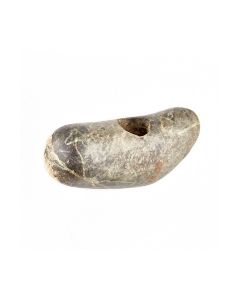 Finely polished hammer axe
Finely polished hammer axeThe compact axe head is made of beautiful and polished green-black stone with white veins. Late Neolithic to Copper Age.
Price: on request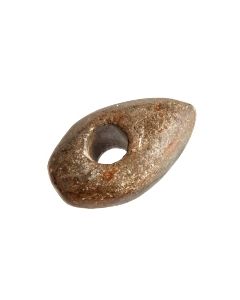 Small battle axe of the Single Grave culture
Small battle axe of the Single Grave cultureThe axe head from the younger Stone Age has a compact shape. Axes that have clearly been used as weapons are rare. Most axe types have probably served peaceful purposes.
Price: on request Polished stone age axe head
Polished stone age axe headThe small tool from the younger Stone Age has a nicely polished surface revealing the beautiful black stone it is made of. Approx. 4200 to 2400 BC.
Price: on request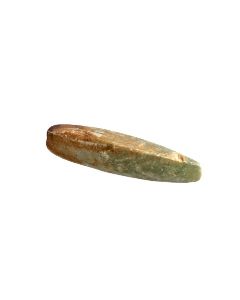 Neolithic chisel of green stone
Neolithic chisel of green stoneThe stone age tool of the younger Funnel beaker culture or Single Grave culture is exceptional because if its material. It is made of beautiful finely polished green stone.
Price: on request Neolithic flint sickle
Neolithic flint sickleHalfmoon shaped blade with fine edges. Nice and typical example for this neolithic type of tool.
Price: on request Neolithische Steinpfeilspitzen der Ounjougou-Kultur
Neolithische Steinpfeilspitzen der Ounjougou-KulturOriginal Funde aus der Region der steinzeitlichen Ounjougou-Kultur in Nordafrika, westliche Sahara. Ca. 5000 bis 3000 v.Chr, Neolithikum.
Price: on request Flintwerkzeuge, Trichterbecherkultur, Frühneolithikum (L1B)
Flintwerkzeuge, Trichterbecherkultur, Frühneolithikum (L1B)Steinzeitliche Werkzeuge aus Flint / Feuerstein. Deutlich bearbeitet. Etwa 3400 v.Chr. Frühneolithikum (Fuchsbergstufe). Ältere Trichterbecherkultur
Price: on request Flintwerkzeuge, Trichterbecherkultur, Frühneolithikum (L1C)
Flintwerkzeuge, Trichterbecherkultur, Frühneolithikum (L1C)Steinzeitliche Werkzeuge aus Flint / Feuerstein. Deutlich bearbeitet. Etwa 3400 v.Chr. Frühneolithikum (Fuchsbergstufe). Ältere Trichterbecherkultur
Price: on request Flintwerkzeuge, Trichterbecherkultur, Frühneolithikum (L1A)
Flintwerkzeuge, Trichterbecherkultur, Frühneolithikum (L1A)Steinzeitliche Werkzeuge aus Flint / Feuerstein. Deutlich bearbeitet. Etwa 3400 v.Chr. Frühneolithikum (Fuchsbergstufe). Ältere Trichterbecherkultur
Price: on request Dicknacken Beil, Trichterbecher Kultur
Dicknacken Beil, Trichterbecher KulturSteinwerkzeug aus dem Frühneolithikum bis Mittelneolithikum, 4200-2800 v. Chr., ca. 55x45x25mm.
Price: on request Flintmesser, Trichterbecherkultur
Flintmesser, TrichterbecherkulturSteinzeitliche Messer aus Flint / Feuerstein. Deutlich bearbeitet. Etwa 3400 v.Chr. Frühneolithikum (Fuchsbergstufe). Ältere Trichterbecherkultur.
Price: on request Neolithische Pfeilspitze der Adlerberg-Kultur
Neolithische Pfeilspitze der Adlerberg-KulturFein bearbeitete Steinpfeilspitze. 2100-1800 v.Chr., Länge 40mm.
Price: on request

